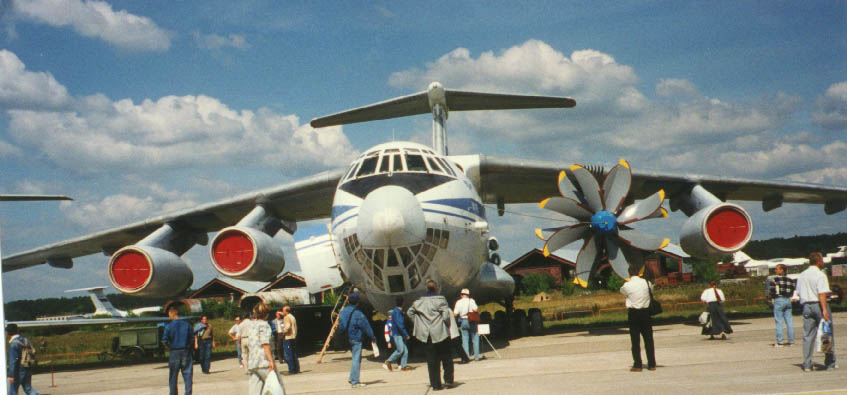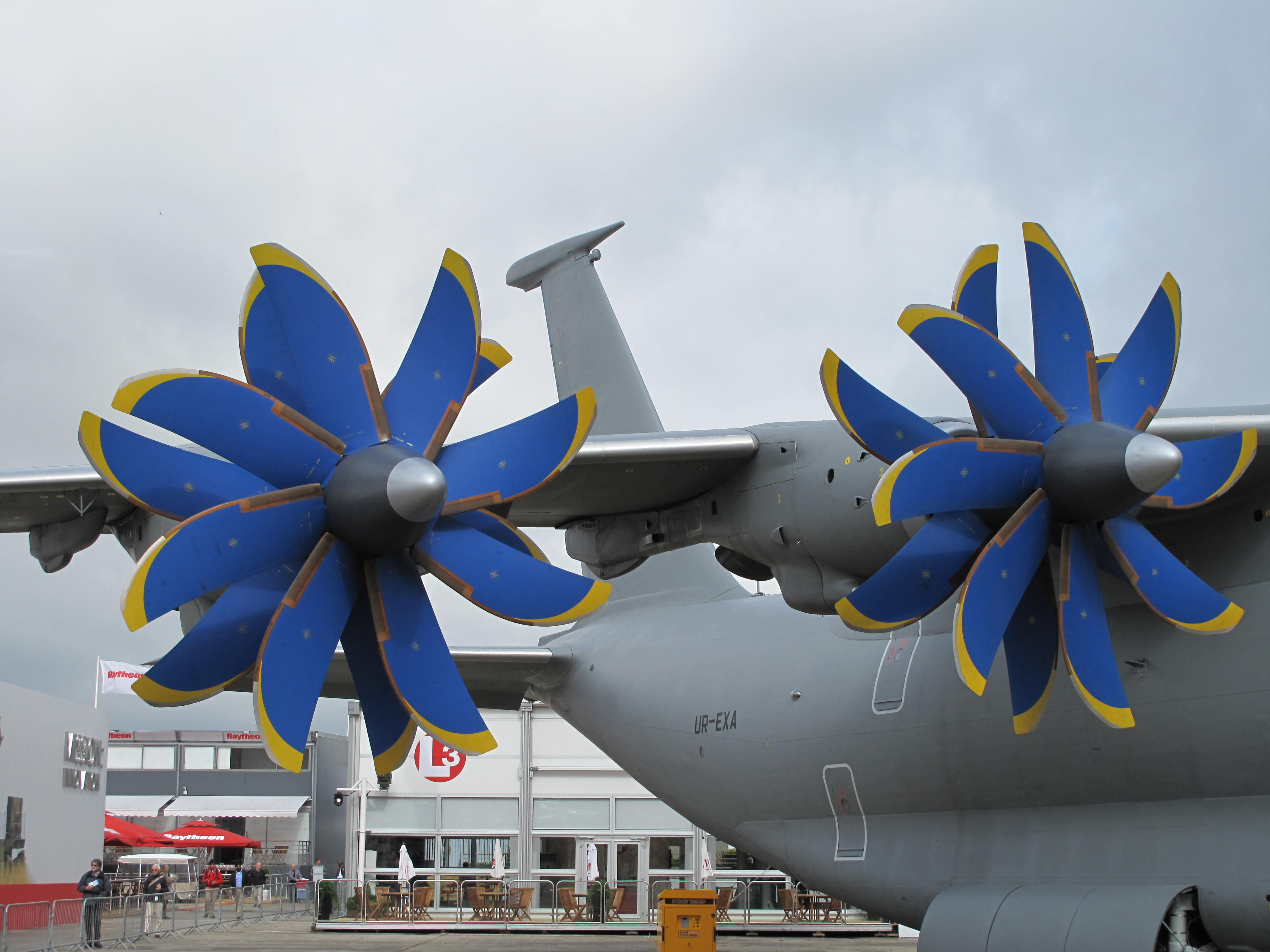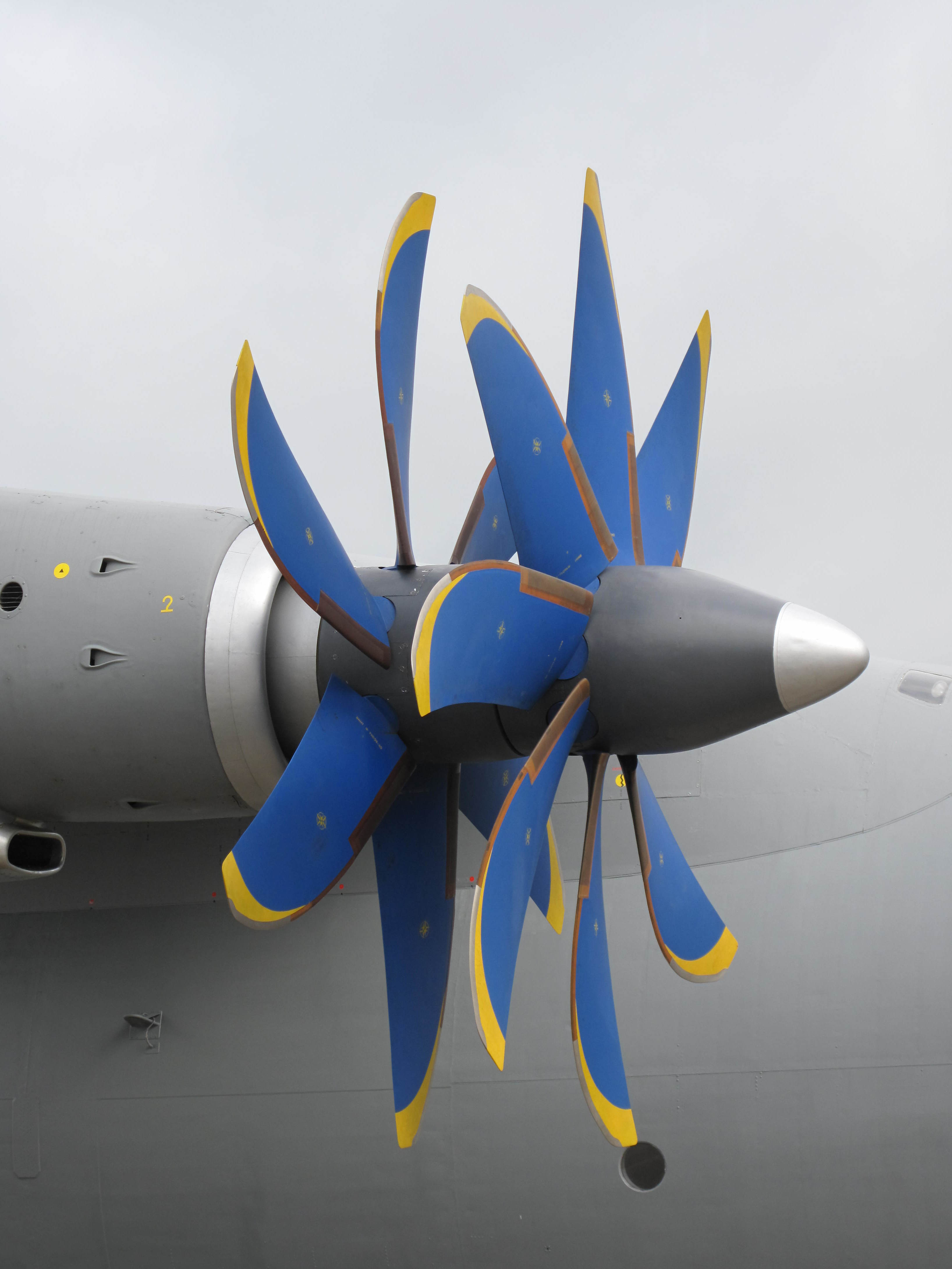Progress D-27 on:
[Wikipedia]
[Google]
[Amazon]
The Progress D-27 is a three-shaft propfan engine developed by Ivchenko Progress. The gas generator was designed using experience from the Lotarev D-36
 A single prototype of the D-27 engine was used for
A single prototype of the D-27 engine was used for
 Ivchenko-Progress worked on derivatives based on the D-27 engine core, mostly within the 1988-1995 time frame. Proposals included the following designs:
;D-27A: designation of the engines for the Beriev A-42PE jet-powered search and rescue (SAR) amphibious aircraft, which was proposed in 1994.
;D-27M: a variant.
;D-127: a
Ivchenko-Progress worked on derivatives based on the D-27 engine core, mostly within the 1988-1995 time frame. Proposals included the following designs:
;D-27A: designation of the engines for the Beriev A-42PE jet-powered search and rescue (SAR) amphibious aircraft, which was proposed in 1994.
;D-27M: a variant.
;D-127: a  ;D-527: an engine with an ultra-high
;D-527: an engine with an ultra-high
 *
*
turbofan
The turbofan or fanjet is a type of airbreathing jet engine that is widely used in aircraft propulsion. The word "turbofan" is a portmanteau of "turbine" and "fan": the ''turbo'' portion refers to a gas turbine engine which achieves mechanic ...
. The D-27 engine was designed to power more-efficient passenger aircraft such as the abandoned Yakovlev Yak-46 project, and it was chosen for the Antonov An-70
The Antonov An-70 ( uk, link=no, Антонов Ан-70) is a four-engine medium-range transport aircraft, and the first aircraft to take flight powered only by propfan engines. It was developed in the late 1980s by the Antonov Design Bureau ...
military transport aircraft. As of 2019, the D-27 is the only contra-rotating
Contra-rotating, also referred to as coaxial contra-rotating, is a technique whereby parts of a mechanism rotate in opposite directions about a common axis, usually to minimise the effect of torque. Examples include some aircraft propellers, res ...
propfan engine to enter service.
Design and development
The engine was launched in 1985 by theIvchenko-Progress
Ivchenko-Progress ZMKB ( uk, Запорізьке машинобудівне конструкторське бюро «Прогрес» ім. О.Г.Івченка, ''Zaporizhzhia Machine-Building Design Bureau "Progress" State Enterprise named af ...
Design Bureau for commercial and military transport aircraft. It was designed to meet the expected growth in demand for new aero engines for civil and military applications. It has a take-off rating of for the Antonov An-70
The Antonov An-70 ( uk, link=no, Антонов Ан-70) is a four-engine medium-range transport aircraft, and the first aircraft to take flight powered only by propfan engines. It was developed in the late 1980s by the Antonov Design Bureau ...
. Gunston lists ratings between for the engine.
In 1990, the D-27 engine was proposed for the 150-162 seat Yakovlev Yak-46 airliner. This twin-engined derivative of the three-engine Yakovlev Yak-42
The Yakovlev Yak-42 (russian: Яковлев Як-42; NATO reporting name: "Clobber") is a 100/120-seat three-engined mid-range passenger jet developed in the mid 1970s to replace the technically obsolete Tupolev Tu-134. It was the first airlin ...
would mount the two D-27 engines on the rear fuselage. At the time, the D-27 had a fan, produced at takeoff resulting in a thrust of , and had a thrust specific fuel consumption
Thrust-specific fuel consumption (TSFC) is the fuel efficiency of an engine design with respect to thrust output. TSFC may also be thought of as fuel consumption (grams/second) per unit of thrust (newtons, or N), hence ''thrust-specific''. This fi ...
(SFC) of at a cruise speed of .
 A single prototype of the D-27 engine was used for
A single prototype of the D-27 engine was used for flight testing
Flight testing is a branch of aeronautical engineering that develops specialist equipment required for testing aircraft behaviour and systems. Instrumentation systems are developed using proprietary transducers and data acquisition systems. D ...
on an Ilyushin Il-76 modified as a testbed aircraft
A testbed aircraft is an aeroplane, helicopter or other kind of aircraft intended for flight research or testing the aircraft concepts or on-board equipment. These could be specially designed or modified from serial production aircraft.
Use of te ...
since at least 1992, in preparation for use on the Antonov An-70T military transport aircraft
A military transport aircraft, military cargo aircraft or airlifter is a military-owned transport aircraft used to support military operations by airlifting troops and military equipment. Transport aircraft are crucial to maintaining supply ...
. The version of the D-27 for the An-70T produced and now had propellers. In 1993, the Il-76LL testbed with D-27 engine was put on static display at Moscow's MAKS Air Show
MAKS (russian: МАКС, russian: label=short for, Международный авиационно-космический салон, Mezhdunarodnyj aviatsionno-kosmicheskij salon, "International Aviation and Space Show") is an international air ...
, and the next year it flew at the ILA Berlin Air Show
The ILA Berlin Air Show (German: Internationale Luft- und Raumfahrtausstellung (ILA)) combines a major trade exhibition for the aerospace and defence industries with a public airshow.
It is held every even year at the new Berlin ExpoCenter Airp ...
and the Farnborough Air Show. The testbed configuration made a final appearance at the MAKS Air Show in 1997.
On December 16, 1994, four D-27 engines powered the first An-70 prototype on its maiden flight. This was the first aircraft flight ever to be completely powered by propfan engines. However, the prototype suffered a crash during its fourth flight in February 1995, destroying the aircraft and leaving no survivors. Antonov constructed a second prototype, which made its maiden flight on April 24, 1997 with four new D-27 engines. During its test program, the prototype also flew to the 1997 MAKS Air Show and the 1998 ILA Berlin Air Show.
The D-27's three-shaft gas turbine engine has an axial low-pressure compressor, a mixed-flow high-pressure compressor, an annular combustion chamber, a single-stage high-pressure turbine, and a single-stage low-pressure turbine. The SV-27 contra-rotating propfan, provided by SPE Aerosila, is driven by a four-stage turbine via a shaft connected to a planetary reduction gear which incorporates a thrust meter. The eight-bladed front propeller receives most of the engine power output and provides most of the thrust, while the back propeller has only six blades. The propellers rotate at 1,000 revolutions per minute ( rpm) at takeoff and 850 rpm at cruise. The engine has an overall thermal efficiency of 37 percent.
On December 23, 2005, Antonov announced that the An-70-100 was awarded a noise certificate stating that the D-27-powered aircraft met Stage 3 noise regulations, which permitted international airlines to fly the aircraft unrestricted. In response to the US Stage 4 civil noise regulations adopted in 2006, the engine was modified in 2007 to reduce noise by increasing the separation between the front and back propellers. A further noise-related change in propeller spacing was made in 2010–2012, resulting in a 50-percent increase in separation from .
The Ukrainian armed forces accepted the An-70 with D-27 engines into army service on January 19, 2015.
On September 3, 2019, the Russian navy decided to order Beriev A-42 amphibious aircraft, the development of which had been suspended in 1993. The aircraft would probably use two D-27 propfans as the powerplant. The initial order was for three aircraft, but no timeline was announced.
Variants
 Ivchenko-Progress worked on derivatives based on the D-27 engine core, mostly within the 1988-1995 time frame. Proposals included the following designs:
;D-27A: designation of the engines for the Beriev A-42PE jet-powered search and rescue (SAR) amphibious aircraft, which was proposed in 1994.
;D-27M: a variant.
;D-127: a
Ivchenko-Progress worked on derivatives based on the D-27 engine core, mostly within the 1988-1995 time frame. Proposals included the following designs:
;D-27A: designation of the engines for the Beriev A-42PE jet-powered search and rescue (SAR) amphibious aircraft, which was proposed in 1994.
;D-27M: a variant.
;D-127: a turboshaft
A turboshaft engine is a form of gas turbine that is optimized to produce shaftpower rather than jet thrust. In concept, turboshaft engines are very similar to turbojets, with additional turbine expansion to extract heat energy from the exhaust ...
engine with a rated power of ; intended to power the Mil Mi-26
The Mil Mi-26 (russian: link=no, Миль Ми-26, NATO reporting name: Halo) is a Soviet/Russian heavy transport helicopter. Its product code is ''Izdeliye 90''. Operated by both military and civilian operators, it is the largest and most po ...
M heavy transport helicopter, with production targeted for 1998.
;AI-127: a helicopter engine with an output rating of , derived from the D-27. The engine has a power SFC of at takeoff and at cruise.
;D-227: an unducted propfan that could be gearless (direct-drive) or geared, with an output rating of . This engine was intended for the Antonov An-170, a derivative of the An-70, and it was proposed for the Tupolev Tu-334.
 ;D-527: an engine with an ultra-high
;D-527: an engine with an ultra-high bypass ratio
The bypass ratio (BPR) of a turbofan engine is the ratio between the mass flow rate of the bypass stream to the mass flow rate entering the core. A 10:1 bypass ratio, for example, means that 10 kg of air passes through the bypass duct for ev ...
of 18 that was considered for the Tupolev Tu-334. Nicknamed "super contrafan," the D-527 was ducted and had direct-drive contra-rotating
Contra-rotating, also referred to as coaxial contra-rotating, is a technique whereby parts of a mechanism rotate in opposite directions about a common axis, usually to minimise the effect of torque. Examples include some aircraft propellers, res ...
fans mounted at the rear of the engine, like Rolls-Royce
Rolls-Royce (always hyphenated) may refer to:
* Rolls-Royce Limited, a British manufacturer of cars and later aero engines, founded in 1906, now defunct
Automobiles
* Rolls-Royce Motor Cars, the current car manufacturing company incorporated in ...
's proposed RB529 "Contrafan".
;D-627: a super-high bypass ratio turbofan
The turbofan or fanjet is a type of airbreathing jet engine that is widely used in aircraft propulsion. The word "turbofan" is a portmanteau of "turbine" and "fan": the ''turbo'' portion refers to a gas turbine engine which achieves mechanic ...
engine with a takeoff thrust of up to . An alternative engine for the Yakovlev Yak-46, the D-627 was designed to have a specific fuel consumption not exceeding at a cruise altitude of and a cruise speed of Mach 0.8 (). The D-627 had coaxial contra-rotating fans with a differential gearbox
Propulsion transmission is the mode of transmitting and controlling propulsion power of a machine. The term ''transmission'' properly refers to the whole drivetrain, including clutch, gearbox, prop shaft (for rear-wheel drive vehicles), differe ...
.
;D-727: a variant for the commercial version of the An-70, called the An-70T. A high-bypass turbofan engine, the D-727 has a bypass ratio of 12.85. The D-727 was also the powerplant for the Yak-46-1, the high-bypass turbofan version of the Yakovlev Yak-46.
;AI-727: a range of ultra-high bypass ratio (of nearly 13), geared turbofan
The geared turbofan is a type of turbofan aircraft engine, with a gearbox between the fan and the low pressure shaft to spin each at optimum angular velocities.
Technology
In a conventional turbofan, a single shaft (the "low-pressure" or LP sh ...
engines with a low-noise, wide-chord fan; and thrust between . This engine had a takeoff thrust SFC (TSFC) of and a cruise TSFC of . The engine was offered to power the Antonov An-148T and the Irkut MS-21.
Applications
 *
* Antonov An-70
The Antonov An-70 ( uk, link=no, Антонов Ан-70) is a four-engine medium-range transport aircraft, and the first aircraft to take flight powered only by propfan engines. It was developed in the late 1980s by the Antonov Design Bureau ...
* Antonov An-180 (abandoned)
* Beriev A-42
* Ilyushin Il-76 (testbed)
* Tupolev Tu-334 (rejected)
* Tupolev Tu-95MS (proposed re-engine)
* Yakovlev Yak-44 (abandoned)
* Yakovlev Yak-46 (abandoned)
Specifications
See also
References
Citations
Bibliography
* * * * * * * * * * * *External links
* * * * {{Ivchenko aeroengines Propfan engines Ivchenko-Progress aircraft engines